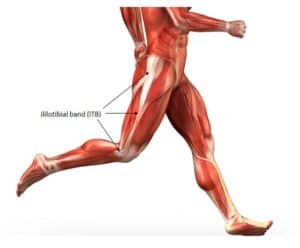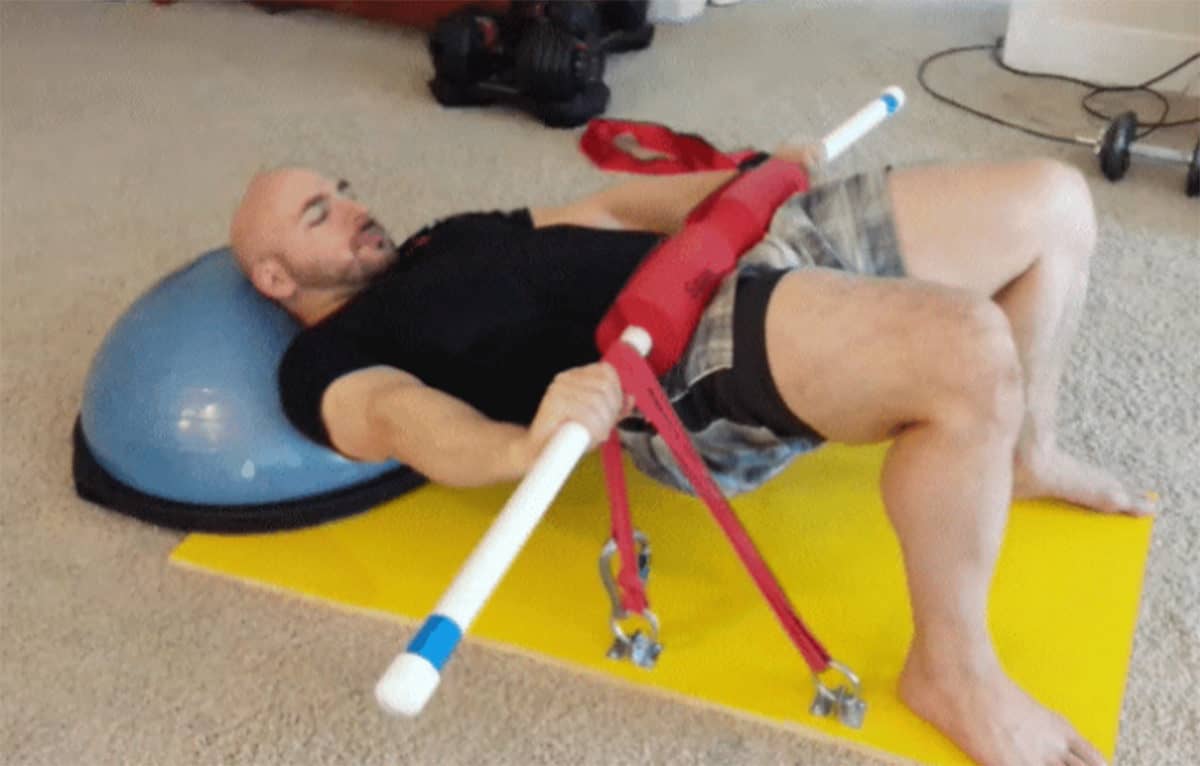There are many causes of pain in your legs, but if you find you have pain in your quads that run down the outside of your legs, it may be your IT Bands. Here’s how to test for the pain source, and some of the best ways to treat it.
IT Bands Defined
The Iliotibial Band (IT Band) is a thick fibrous tendon that extends along the outside of your leg from hip to knee. This tendon is responsible for holding your quad and tibia stable when running or bending your leg.[i]

What to do if your IT Band hurts?
IT bands should be treated like other repetitive use injuries (shin splints, tennis elbow, etc.) If it’s hurting, you need to stop doing the action that’s causing the pain so it can heal. If you hurt it running, you have to stop running, otherwise it’ll only get worse.
So what’s going on physically if your IT Bands hurts?
Basically it’s an inflamed tendon because something is wrong with your gait, exercise technique, or musculature. In most cases you are loading more force on this tendon than it’s designed to hold. [ii]
So how do you heal an inflamed IT Band?
You need to reduce your inflammation and offload the source of extra stress being put onto your IT Band. Often a very tight TFL can cause this problem. A tight TFL can be caused by … underactive glutes.
How do I reduce inflammation in my IT Band?
Rest is rule number #1. Stop doing the action that caused the pain. Also, use anti-inflammatory techniques like ice and compression, take your anti-inflammatory supplements like omega 3 fish oil and Advil or Aleve, and eat your anti-inflammatory foods (pineapple, papayas, apples, ginger, turmeric, etc.) More than that, you need to address the muscle dysfunction that lead to the tight IT-band in the first place.
So what are sources of extra stress on your IT Band?
Weak or inactive glutes, adductors, and abductors. Sort of. Actually glutes and “abductors” are the same muscle so it’s just glues and adductors. But the glutes and adductors compose a number of muscles including glute maximumus, glute medius, glute minimumus, adductor brevis, adductor longus, adductor magnus, and adductor minimus.[iii] Your abductors (the muscles that bring your legs away from your dorsal/sagittal plane) are you glutes! But before you sit in that famous Gyno Chair machine, consider that that machine is designed to work your glute medius and glute minimus by putting your knee in a bent position when you are sitting.[iv] How often does that position occur real life? It’s not a functional movement,[v] and is perhaps only use to strengthen a weakened muscle or for hypertrophy purposes (but use caution because injuries are prominent in some of these machines.)
OK, how do I strengthen my butt muscles?
Lots of ways: lateral steps (with tension band), curtsy lunge, bosu side steps, glute bridge with a ball in your knees, one leg roman deadlift, most single leg stabilization movements, Marx Row, etc.
Hip Thruster by Bret Contreras
Home Version of Hip Thruster

So what do the glutes actually do? Depends on which glute muscle you are asking about. Leg extension at knee are powered by the glute maximimus. Leg abduction (move your leg away from your midplane) – glute medius or minimum depending on the angle of your knee angle. Internal or external leg rotation with hips extended are powered by your glute medius and minimums.[vi] Oh, and they give you a really nice looking butt, so work them. More than that they are really strong muscles and are considerably important in Olympic lifting and kettle bell movements. Other than pain along the side of your leg, a tell-tale sign of IT Band issues (and weak glutes) are over-fatigued quadriceps. If your glutes aren’t doing their job, something has to take up the slack. In most cases, that’s your quadriceps. If your trainer has you doing a lot of squats or kettle movements (like make all our clients do), and you’re finding that your quads are getting tired… that’s a red flag that your glutes aren’t activated (i.e contracting properly). Seeing a muscle activation therapist (MAT) may be helpful (palpations can assist.)

Therapy by rolling and myofascia release techniques: Glutes can be massaged by use of Trigger Point Ball, STI rumble rollers (right), and the IT Band can be massaged through a Grid Roller or foam roller. This provides minor relief, but won’t really get the heart of the problem.
Therapy by body massager and Electro Muscle Stimulation (EMS): On the IT-Bands themselves, use of a body massager like the Hitachi Body Wand or the Maxi Rub may help alleviate some of the pain on the IT Bands. On the glutes, body massage tools are particularly effective provided the user’s fat percentage is low enough for the vibrations to penetrate (and you have a trainer to apply the massage tool). Body massagers are generally useful for recovery, but alone they won’t reactive any deactivated glutes. As for electrostim, it’s not a good idea for IT Bands (don’t use electrostim on tendons). On the glutes, EMS has been shown to be effective in some small scale studies, and can be used in combination with strength training on the glutes.[vii], [viii]. We use them in combination with the exercises about to get the glutes firing overtime.
Bottom Line Summary on IT Band Issues: Rest them, use anti-inflammatory techniques, and increase your glute and adductor muscle strength to offload some of the work your TFL is doing.


